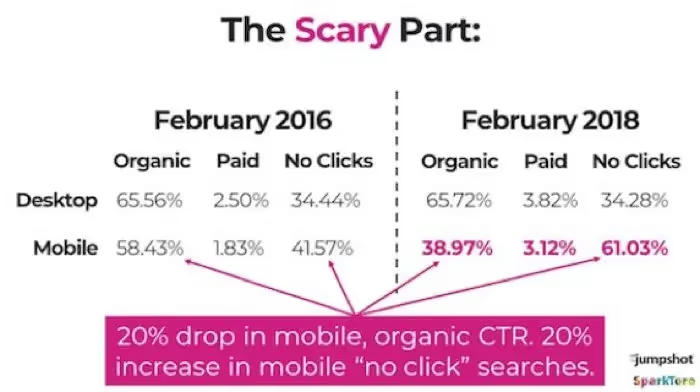4 Current New SEO Trends [2018]

Brighton SEO It's a Annual Conference which is being held in that city in the United Kingdom with a variety of SEO agencies talking about latest trends and developments in SEO. Our colleagues from Novicell UK attended this year and told us what they learned from SEO experts who listened.
4 SEO Trends in 2018
1. Tracking websites with lots of URLs
Rachel Costello from Deepcrawl gave us an excellent idea, related to the Technical SEO, of How to crawl websites with more than a million URLs.
Large company websites with millions of URLs can be extremely difficult to manage at first, especially with a limited crawl budget.
El tracking budget of your website is the number of times that search engine robots visit your web pages in a given period of time. Because websites aren't alone on the internet, these robots (or trackers and spiders) will also divert your attention elsewhere.
Most don't need to worry too much about the crawl budget, as this mainly concerns the sites of very large companies, but that doesn't mean we should forget about it.
If you need them trackers find the content and the most important pages as soon as possible, you can consult the Google Search Console to see the tracking statistics in the “Crawl” menu.
El use of daily tracking statistics will allow you to calculate your monthly crawl budget, allowing you to calculate a baseline for the number of pages that spiders will crawl in a month.
Optimizing the tracking budget
Un Example of optimizing the tracking budget What was presented at BrightonSEO was that a customer had separate product pages for the same product but in different sizes and colors.
So, 1 product in 10 sizes and 10 different colors means 100 additional pages and URLs instead of 1. This can add up very quickly if there are thousands of products in a e-commerce great. In addition to this, filter pages were also being indexed.
All those big user experience filters to help visitors search by size, color, prize, sort by ascending, descending, price, most popular. These parameters can quickly have thousands of URLs for spiders to spend your budget.
How to optimize your tracking budget
The overall goal isn't to increase your tracking budget, but rather to make sure you're using it effectively. You can follow these steps to increase efficiency with which spiders crawl your site:
- Decide which are the most important pages to index
- Optimize your product template to include different sizes, prices and colors
- Fix redirects and broken links
- Clean up your XML sitemap (see the possibility of dividing it into smaller, more manageable sitemaps)
- Set URL parameters
- Use robots.txt
Manage your tracking budget
Tracking a large company site can be increasingly difficult, especially with a limited crawl budget.
Instead of crawling the entire website each time, you can execute selective or tactical traces; segmenting the site into manageable chunks. With software such as Screaming Frog or Deep Crawl, targeted and tactical crawls can be easily completed.
Divide the site you're managing into vertical and more manageable categories, these could be:
- Product pages
- Category pages
- Blog pages
- Vanity pages
- Navigation pages
- Transactional pages
- Frequently Asked Questions pages
Remember, it's still important to fully crawl your site annually.
2. Voice search
Voice search has been described as a “revolution” in the marketing world, and many say it will be the The future of search. The statistics that are being published are: “50% of all searches will be voice by 2020 and in 2017 60% of mobile searches will be voice”.
This might seem likely, as the use of smart speakers has grown exponentially; 90 million users in the United States, in addition to those already using Siri, Cortana and OK Google.
However, The data says otherwise. Only 12% of mobile searches carried out between 2017 and 2018 were done by voice, so we are not yet in the 50% trend.
None of Google's tools currently segment a voice search term, so why bother investing time and money if we still can't crawl properly?
This introduction of voice and highlights in the SERP has contributed to an increase in “no-click” searches. With some results, users don't even need to click to find the answer, Google will tell them, so they don't need to click.

A study found that there has been a decrease in CTR by 20%, questions are being answered on the SERP so users aren't clicking on any results.

This reduced CTR has a direct impact on the Quality Score of Google Ads user accounts: the richer and more prominent the snippets shown in the SERP, the less likely users are to click on an ad.
Which brings us to the question, will Google bring rich media to ads in the future? If more people are experiencing higher costs and lower quality scores, then they may be looking for other ways to advertise.
3. The Featured Snippets
The Featured snippets or Featured excerpts are selected organic search results found at the top of Google's organic results below ads in a box. The purpose of the Featured snippet is to respond more quickly to the user's question.
The good thing about the highlighted excerpts is that they give an immediate answer. Studies have shown the following:
- That the click through rate (CTR) on a featured page increased from 2% to 8% once it was placed in a response box, with a 677% increase in revenue from organic traffic.
- Another study highlights a 20-30% increase in traffic to ConfluentForms.com while they had the snippet highlighted for search.
Key insights
Featured snippets can increase both traffic and sales. Below we describe the 4 most important points:
1. Access the correct query intent
There are 3 different types of search intent:
- Informational
- Navigational
- Transactional
You should try to respond to inquiries that are both informational and transactional, as they will provide you with the relevant traffic that you will convert.
2. Conduct research on problems and solutions
Not only should research problems and solutions be carried out, but also keyword research. The best way to evaluate your audience's questions is to ask them what concerns they have about a specific topic.
There are several ways to get data about the questions your audience may have. You can use the following resources to get ideas:
- Your customer service and sales team
- Answers from AnswerThePublic.com
- Using social media
3. Provide epic, user-centered content that meets a need
You must provide the user with content that solves their problems and show them that you are an expert in that area. Since updating the Google E-A-T (Expertise - Authoritativeness - Trustworthiness) algorithm, you must show the user that you are an expert. Your content must be trustworthy, so be sure to use supporting data and sources, preferably links to these sources in your content. Always write for humans and not for crawlers, so ignore keyword density terms and focus on creating valuable content.
4. Make sure your content is easily understandable
Your content must be understandable and easy to access. To make your content easy to understand, you must:
- Give structure
- Recall the right point of the paragraph in 40-60 words
- Expand your lists
- Highlight your data (Schema.org)
- Use attention-grabbing images
4. Link Building Techniques
Link building remains one of the most important factors in SEO, which takes time and is especially difficult for niche industries, but it pays off in the end when you get links from high-authority websites. Link Building can increase your ranking and, therefore, also your traffic.
Before you start building links, make sure your website follows these guidelines:
- It's easy to navigate and with a clear structure
- The customer journey is satisfactory
- It has an SSL certificate and other trusted reviews
- It has clear Call To Actions
- Contains relevant keywords
- Focuses on E-A-T (Expertise-Authority-Trust) content
These are the 4 key points discussed at BrightonSEO about Link building:
1. Competitive backlinks
The basic resource for obtaining links has been to steal them from your competitors through these steps:
- Identify the 4 biggest competitors
- Put them in a tool like SEMrush or Searchmetrics
- Compare backlink metrics
- Identify links with a high domain rating
- Send an email to get a link
2. Surveys
Polls tend to make their way through the press and attract a lot of links, if the topic of the survey is original, relevant, newsworthy, and interesting to your main audience. Here's how to start creating a survey step by step:
- Identify a question that your target audience would be interested in knowing the answer to. It should be a quantitative question.
- You can search the forums and question and answer websites to find questions that may be of interest to your audience.
- Choose a platform for your survey, such as Google surveys or SurveyMonkey.
- Keep the survey as short as possible to get accurate results about what you want to find out.
- Your questions should not be open-ended.
- When you get the results, identify the most striking information and use it as a heading in your article.
- Explain your results in the article and be sure to contextualize your interpretations.
- Post it on all social media to make it public.
3. Infographic
Making infographics attractive makes it easier to acquire links. The following describes the process of creating great infographics.
- Brainstorming with the whole team
- Investigation
- Brainstorming via email
- Develop concept
- Design
- Revisions
4. Flickr galleries
Image links aren't new or revolutionary, yet it's an underused tactic. The impact of image-based links on the reader, both in terms of user experience and conversion rate optimization, can be incredibly high. Once you've done the setup, it will require minimal effort but will continue to pay off.
Flickr is the YouTube for images and receives a lot of traffic and the site has been designed to share images and give credit to their use through a common creative license. This license is the key to creating links.
The link building technique is simply a transaction; sharing original useful images in exchange for a link back to your site. Follow this step by step to start your Flickr gallery link building strategy.
- Sign up for a Flickr account
- Take as many photos as possible
- Upload these images to Flickr
- Add your file names, descriptions and tags
- Add in the description that users can use your image for free on their website if they place a hyperlink.
- When people use your link, you'll receive back links.
This is a summary of the main insights gained by our colleagues at Novicell in London. Contact us if you have questions or need helps with the SEO of your website.
How can we help you?
If you need more information don't hesitate to get in touch with us.
Cómo podemos ayudarte
Consulta los servicios con los que te ayudaremos a conseguir tus objetivos digitales.
